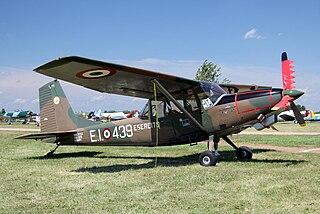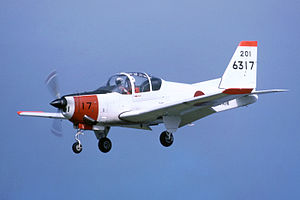
The Convair R3Y Tradewind was an American 1950s turboprop-powered flying boat designed and built by Convair.

The AASI Jetcruzer was an American single turboprop light civil transport made by Advanced Aerodynamics and Structures Inc. The Jetcruzer had an unusual configuration, with a single turboprop engine driving a pusher propeller, a prominent canard, and fins mounted at the ends of its swept wings. The plane has seating for up to six people including the pilot. The Jetcruzer is noteworthy for being the first aircraft to have achieved a spin resistance certification from the United States FAA.

The Valmet L-90 Redigo is a turboprop-powered military basic trainer aircraft and liaison aircraft, a development of Valmet's earlier training aircraft for the Finnish Air Force. The L-90 was the last military aircraft designed and produced in Finland.
The IAR-825 Triumf is a Romanian-designed tandem multirole trainer aircraft based on the IAR-823 built for the Romanian Air Force. The aircraft is roughly in the same class with the Brazilian EMBRAER Tucano. The IAR-825 is equipped with the Canadian Pratt & Whitney Canada PT6 turboprop engine. The type's first flight took place on the 12 June 1982.

The Cessna 441 Conquest II is the first turboprop powered aircraft designed by Cessna and was meant to fill the gap between their jets and piston-engined aircraft. It was developed in November 1974, with the first aircraft delivered in September 1977. It is a pressurized, 8–9 passenger turbine development of the Cessna 404 Titan. The ICAO designator as used in flight plans is C441.

The Cessna 425, known as the Corsair and later as the Conquest I, is an eight-seat American pressurized turboprop twin-engined light aircraft. Now out of production, it was built by Cessna Aircraft of Wichita, Kansas, between 1980 and 1986.

The Fuji T-3 is a primary military trainer aircraft used by the Japan Air Self Defense Force, manufactured by Fuji Heavy Industries. Its first flight was in 1978. In the course of its service life, 50 units were produced. It is has been replaced by the Fuji T-7.
The Valmet L-80 TP Turbo-Vinha was a prototype for a new Finnish turboprop basic trainer aircraft. The aircraft, which carried the registration OH-VBB, first flew on 12 February 1985. It was destroyed in a crash on 24 April 1985, during its 14th flight, killing the test pilot Paavo Janhunen. The aircraft was a further development of the Valmet L-70 Vinka and would eventually lead to the Valmet L-90 Redigo.

The Ahrens AR 404 was a prototype American civil transport aircraft first flown in 1976, a high-wing monoplane powered by four turboprop engines. In order to facilitate the loading and unloading of cargo, the fuselage was of constant rectangular section along almost its entire length, the main undercarriage was retracted into sponsons on the fuselage sides, and the tail included a loading ramp. As a regional airliner, the AR 404 was designed to carry 30 passengers, or in its cargo configuration, to accommodate four standard D3 freight containers.

The AIDC XC-2 was a prototype civil transport aircraft designed in the 1970s in Taiwan. It was a high-wing monoplane powered by two turboprop engines. The main undercarriage was carried in sponsons on either side of the boxy fuselage, maximising internal space.

ENAER T-35 Pillán is a Chilean propeller-driven basic trainer aircraft. The student and the instructor sit in tandem. Production ceased in 1991 after 7 years but restarted briefly in 1998.

The AS/SA 202 Bravo is a two to three-seat civil light aircraft jointly designed and manufactured by the Swiss company Flug- und Fahrzeugwerke Altenrhein (FFA) and the Italian company Savoia-Marchetti. The aircraft was designated the AS 202 in Switzerland, and the SA 202 in Italy.

The Kawasaki P-2J is a maritime patrol and ASW aircraft developed for the Japan Maritime Self-Defense Force. A twin turboprop-powered version of the radial-engined P-2 Neptune, the P-2J was developed as an alternative to buying the larger and more expensive P-3 Orion, which would eventually replace the P-2J in the 1980s.

The SIAI-Marchetti SM.1019 is an Italian STOL liaison monoplane built by SIAI-Marchetti for the Italian Army. It is a turboprop-powered derivative of the Cessna O-1 Bird Dog.

The Aviasud Mistral is a French two-seat ultralight biplane built by Aviasud Engineering. This plane is notable as it has forward swept wings and side-by-side seating. The lower wings are movable and are used as the roll control.

The Vulcanair SF.600 Canguro was a feederliner developed in Italy in the late 1970s. Despite a number of attempts to put the aircraft into series production, only a small number were ever built.

The Fuji T-7 is a Japanese primary trainer aircraft built by Fuji Heavy Industries for the Japan Air Self-Defense Force. A development of Fuji's earlier T-3 trainer, it is a single-engined monoplane powered by a turboprop engine.

The Aeromot AMT-200 Super Ximango is a Brazilian motor glider developed from the AMT-100 Ximango but fitted with a Rotax 912 engine.
The Stoddard-Hamilton T-9 Stalker, Tactical Trainer, was an American military training monoplane designed and built by Stoddard-Hamilton Aircraft of Arlington, Washington and based on the Stoddard-Hamilton Glasair III.
The Jaffe/Swearingen SA-32T is a prototype American turboprop- powered training aircraft with side-by-side seating. A single example was built in the late 1980s, but no production followed.
















